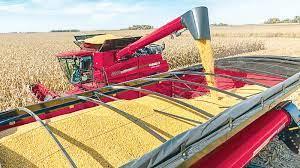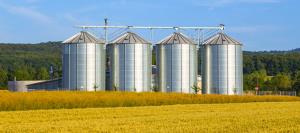 OVERVIEW
OVERVIEW
The USDA provided updated projections for the production of corn and soybeans in the July 11thWorld Agriculture Supply and Demand Estimates (WASDE) #662, reflecting the 2025 crop. Yield values for corn and soybeans were unchanged from the June edition. Projections of crop size and ending stocks are derived from acreage to be planted, recent annual crop yields and with the latest assumptions relating to domestic use and tariff policy influencing exports.
The July 11th WASDE report confirmed that the 2025 corn crop will be harvested from an expanded 86.8 million acres, (82.7 million acres in 2024). The soybean crop will be harvested from a reduced 82.7 million acres, (86.3 million acres in 2024).

The July 11th WASDE yield value for the 2025 corn crop was predicted at 181.0 bushels per acre. By comparison yield was 183.1 bushels per acre in 2024. The projected value for soybean yield was an optimistic 52.5 bushels per acre compared to 51.7 bushels per acre for the previous crop.
The July 11th USDA projection for the ending stock of corn was reduced 5.1 percent to 1,660 million bushels due to a corresponding reduction in beginning stock and harvest quantity. The July USDA projection for the ending stock of soybeans was up 5.1percent to 310 million bushels mainly due to reduced exports.
The July 11th 2024 WASDE projected the corn price for the 2025-2026 market year at an average of 420 cents per bushel. The projected average season price for soybeans was down 1.5 percent to 1,010 cents per bushel. The price of soybean meal was lowered 6.5 percent to $290 per ton. USDA commodity prices suggest stable to lower feed costs for livestock and poultry producers. Row crop farmers will experience declining margins. In some areas corn will be below break-even given relative production costs and per bushel prices. It is probable that high support prices will be required from Commodity Credit Corporation funding if importing nations respond negatively to protective and punitive tariffs imposed by the Administration. Congress has yet to pass a Farm Bill.
Projections for world output included in the July 2025 WASDE report, reflect the most recent estimates for the production and export of commodities especially in the Southern Hemisphere with an emphasis on Argentine and Brazil. Economists also evaluated the likely impacts from the ongoing La Nina event especially on South America and sub-Saharan Africa.
It is accepted that USDA projections for export will be influenced by the fluid situation relating to tariffs. Exports are also based on the perceived intentions and needs of China. This Nation has sharply curtailed purchases of commodities and especially U.S. soybeans during the previous and current market years.
CORN
 Production parameters for corn were unchanged from the July Report. Influenced by harvest data for the 2024 crop and the March 31stProspective Plantings Report, the July WASDE Report projected a 2025 crop of 15,705 million bushels, compared to 15,413 million bushels for the previous 2024 record harvest. The “Feed and Residual” category was lowered to 5,850 million bushels. As of 7th July, 18 percent of the corn crop had attained the silking stage. The Food and Seed category was held at 1,385 million bushels. The Ethanol and Byproducts Category was unchanged at 5,500 million bushels consistent with estimated demand for E-10 and higher blends for summer driving. Projected corn exports were unchanged from July at 2,675 million bushels, based on recent orders and shipments. The anticipated ending stock of corn will be 1,660 million bushels or 9.7 percent of projected availability.
Production parameters for corn were unchanged from the July Report. Influenced by harvest data for the 2024 crop and the March 31stProspective Plantings Report, the July WASDE Report projected a 2025 crop of 15,705 million bushels, compared to 15,413 million bushels for the previous 2024 record harvest. The “Feed and Residual” category was lowered to 5,850 million bushels. As of 7th July, 18 percent of the corn crop had attained the silking stage. The Food and Seed category was held at 1,385 million bushels. The Ethanol and Byproducts Category was unchanged at 5,500 million bushels consistent with estimated demand for E-10 and higher blends for summer driving. Projected corn exports were unchanged from July at 2,675 million bushels, based on recent orders and shipments. The anticipated ending stock of corn will be 1,660 million bushels or 9.7 percent of projected availability.
The forecast USDA average season farm price for corn in the June WASDE report covering the 2025 crop was 420 cents per bushel. At close of trading on July 11th after the noon release of the WASDE, the CME spot price for corn was 412 cents per bushel, 1.9 percent below the USDA July projection and down 6.2 percent from June 12th 2025.
JULY 2025 WASDE #662 Projections for the 2025 Corn Harvest:
|
Harvest Area
|
86.8 m acres
|
(95.2 m. acres planted), harvest corresponding to 91.2% of acres planted)
|
|
Yield
|
181.0 bushels per acre
|
(Updated from 179.3 bushels per acre in the February WASDE reflecting the 2024 crop)
|
|
Beginning Stocks
|
1,340 m. bushels
|
|
|
Production
|
15,705 m. bushels
|
|
|
Imports
|
25 m. bushels
|
|
|
Total Supply
|
17,070 m. bushels
|
Proportion of Supply
|
|
Feed & Residual
|
5,850 m. bushels
|
34.3%
|
|
Food & Seed
|
1,385 m bushels
|
8.1%
|
|
Ethanol & Byproducts
|
5,500 m. bushels
|
32.2%
|
|
Domestic Use
|
12,735m. bushels
|
74.6%
|
|
Exports
|
2,675 m. bushels
|
15.7%
|
|
Ending Stocks
|
1,660 m. bushels
|
9.7%
|
Average Farm Price: 420 cents per bushel. (Unchanged since the May WASDE)
SOYBEANS
 Yield for soybeans was unchanged from the June Report. Influenced by harvest data for the 2024 corn crop and an estimated yield of 52.5 bushels per acre, albeit with reduced acreage planted, the July WASDE Report projected the soybean harvest to be 4,335 million bushels. As of July 7th, 96 percent of the soybean crop had emerged. Crush volume was projected at 2,540 million bushels up 2.0 percent, disproportionate to recently increased industry capacity. Projected exports were predicted to be 1,745 million bushels, down 3.9 percent attributed to the prospect of reduced imports by China following uncertainty over tariffs and diplomatic conflict. Ending stocks were anticipated to be 310 million bushels, up 5.1 percent from the June WASDE report. Prior to 2018, China, the largest trading partner for U.S. agricultural commodities, imported the equivalent of 25 percent of U.S. soybeans harvested.
Yield for soybeans was unchanged from the June Report. Influenced by harvest data for the 2024 corn crop and an estimated yield of 52.5 bushels per acre, albeit with reduced acreage planted, the July WASDE Report projected the soybean harvest to be 4,335 million bushels. As of July 7th, 96 percent of the soybean crop had emerged. Crush volume was projected at 2,540 million bushels up 2.0 percent, disproportionate to recently increased industry capacity. Projected exports were predicted to be 1,745 million bushels, down 3.9 percent attributed to the prospect of reduced imports by China following uncertainty over tariffs and diplomatic conflict. Ending stocks were anticipated to be 310 million bushels, up 5.1 percent from the June WASDE report. Prior to 2018, China, the largest trading partner for U.S. agricultural commodities, imported the equivalent of 25 percent of U.S. soybeans harvested.
The USDA WASDE July projection for the ex-farm price for soybeans for the 2025 harvest was 1,010 cents per bushel. At close of trading on July 11th following release of the WASDE, the CME spot price was 1,007 cents per bushel, 0.3 percent below the July USDA projection and 3.4 percent below the June 12th price.
JULY 2025 WASDE #662 Projection for the 2025 Soybean Harvest:-
|
Harvest Area
|
82.5 m acres
|
83.4 m. acres planted. Harvest corresponding to 99.2% of planted acreage)
|
|
Yield
|
52.5 bushels per acre
|
(Up from 51.7 bushel/acre attained in 2024)
|
|
Beginning Stocks
|
350 m. bushels
|
|
|
Production
|
4,335 m. bushels
|
|
|
Imports
|
20 m. bushels
|
|
|
Total Supply
|
4,705 m. bushels
|
Proportion of Supply
|
|
Crush Volume
|
2,540 m. bushels
|
54.0%
|
|
Exports
|
1,815 m. bushels
|
38.5%
|
|
Seed
|
73 m. bushels
|
1.6%
|
|
Residual
|
37 m. bushels
|
0.8%
|
|
Total Use
|
4,395 m. bushels
|
93.4%
|
|
Ending Stocks
|
310 m. bushels
|
6.6%
|
Average Farm Price: 1,010 cents per bushel (Down 15 cents per bushel from June WASDE)
SOYBEAN MEAL
Production parameters for soybean meal were updated from the June Report. The projected production of soybean meal from the 2025 soybean crop will be 59.9 million tons, consistent with a 2.0 percent increase in crush volume to 2,540 million bushels. Projected production reflects the stagnant demand for biodiesel despite expanded U.S. crushing capacity. According to NOPA, the crush volume in May was 205 million bushels. Crush volume is driven both by exports and domestic consumption for livestock feed and for soy oil supplying the food and biodiesel segments. The projection of domestic use was 41,325 million tons. Exports were estimated at 18.7 million tons.
The USDA projected the ex-plant price of soybean meal at $290 per ton was down 6.5 percent from the June WASDE as an average for the season based on supply and demand considerations. USDA predicted an ending stock of 475,000 tons representing 0.8 percent of supply.
At close of trading on July 11th the CME spot price for soybean meal was $284 per ton, down 2.0 percent from the July WASDE projection of $290 per ton and down 3.7 percent from June 12th.
JULY 2025 WASDE #662 Projection of Soybean Meal Production and Use
|
Beginning Stocks
|
450
|
|
Production
|
59,850
|
|
Imports
|
650
|
|
Total Supply
|
60,950
|
|
Domestic Use
|
41,775
|
|
Exports
|
18,700
|
|
Total Use
|
60,475
|
|
Ending Stocks
|
475
|
(Quantities in thousand short tons)
Average Price ex plant:$290 per ton (Down $20 per ton from June WASDE)
IMPLICATIONS FOR PRODUCTION COST
The price projections based on CME quotations for corn and soybeans suggest lower feed production costs for broilers and eggs. Going forward, prices of commodities will be determined by World supply and demand and U.S. domestic yield, use and exports.
For each 10 cents per bushel change in corn:-
- The cost of egg production would change by 0.45 cent per dozen
- The cost of broiler production would change by 0.25 cent per live pound
For each $10 per ton change in the cost of soybean meal:-
- The cost of egg production would change by 0.35 cent per doze
- The cost of broiler production would change by 0.30 cent per live pound.
WORLD SITUATION
With respect to world coarse grains and oilseeds the June 2025 WASDE Report included the following appraisals by USDA:-
COARSE GRAINS:
“Global coarse grain production for 2025/26 is forecast 3.6 million tons lower to 1.547 billion. This month’s 2025/26 foreign coarse grain outlook is for lower production, total use, and stocks relative to last month. Foreign corn production is raised reflecting area increases for Canada and Mexico. For 2024/25, corn production is raised for Brazil and the Philippines with a partly offsetting decline for Mexico. Brazil corn yield expectations are boosted this month based on reported second crop harvest results to date for the Center-West. Foreign barley production for 2025/26 is down with cuts for Turkey, Russia, the EU, Ukraine, and United Kingdom partly offset by larger production prospects for Kazakhstan”.
“Major global trade changes for 2025/26 include larger corn imports for Zimbabwe and Egypt but reductions for Canada and Mexico. For 2024/25 corn exports are raised for the United States and Canada but lowered for Turkey. Foreign corn ending stocks for 2025/26 are cut, with reductions for China and India partly offset by an increase for Brazil. Global corn stocks, at 272.1 million tons, are down 3.2 million”.
OILSEEDS:
 “Global soybean supply and demand forecasts for 2025/26 include higher supply, increased crush, lower exports, and higher ending stocks. Beginning stocks are raised on trade revisions in the prior marketing year. Higher beginning stocks for Brazil are partly offset by lower stocks for China, Mexico, and Ukraine. Global soybean production is raised on higher production for Ukraine based on observed government planting progress data. Global crush is raised 1.1 million tons to 367.7 million. Crush is raised for the United States, Ukraine, and Turkey, but lowered for India, Mexico, and Saudi Arabia. As a result of higher global soybean crush, global soybean meal trade is raised this month with higher imports for Colombia, Iran, Saudi Arabia, Mexico, and Vietnam”.
“Global soybean supply and demand forecasts for 2025/26 include higher supply, increased crush, lower exports, and higher ending stocks. Beginning stocks are raised on trade revisions in the prior marketing year. Higher beginning stocks for Brazil are partly offset by lower stocks for China, Mexico, and Ukraine. Global soybean production is raised on higher production for Ukraine based on observed government planting progress data. Global crush is raised 1.1 million tons to 367.7 million. Crush is raised for the United States, Ukraine, and Turkey, but lowered for India, Mexico, and Saudi Arabia. As a result of higher global soybean crush, global soybean meal trade is raised this month with higher imports for Colombia, Iran, Saudi Arabia, Mexico, and Vietnam”.
“Global soybean exports are lowered as reduced U.S. exports are partly offset by higher exports for Argentina and Ukraine. Imports are lowered for India, Mexico, and Saudi Arabia. Global soybean ending stocks are increased 0.8 million tons to 126.1 million on higher stocks for Brazil and the United States partly offset by lower stocks for China, Argentina, and Mexico”.
World and U.S. Data Combined for Coarse Grains and Oilseeds:-
|
Factor: Million m. tons
|
Coarse Grains
|
Oilseeds
|
|
Output
|
1,547*
|
694
|
|
Supply
|
1,860
|
837
|
|
World Trade
|
238
|
215
|
|
Use
|
1,561
|
581
|
|
Ending Stocks
|
299
|
145
|
*Values rounded to one million metric ton
(1 metric ton corn= 39.37 bushels. 1 metric ton of soybeans = 36.74 bushels)
(“ton” represents 2,000 pounds)